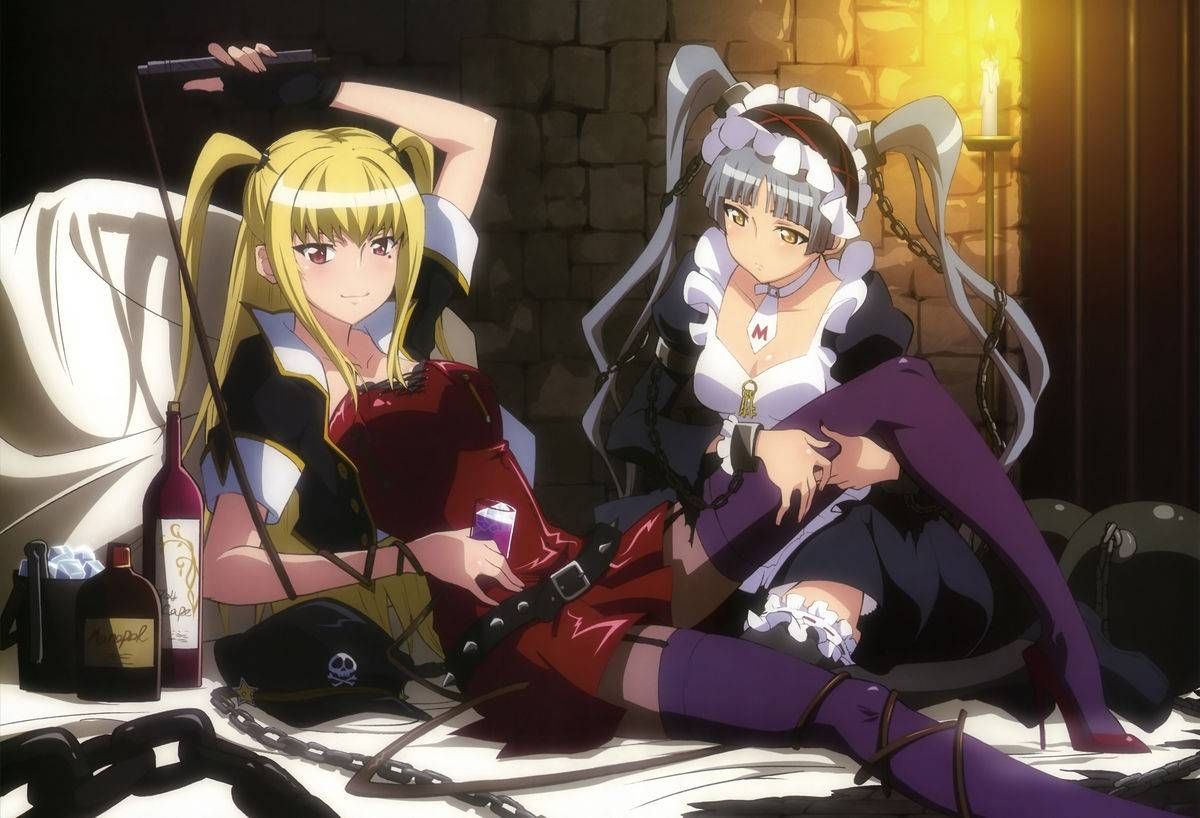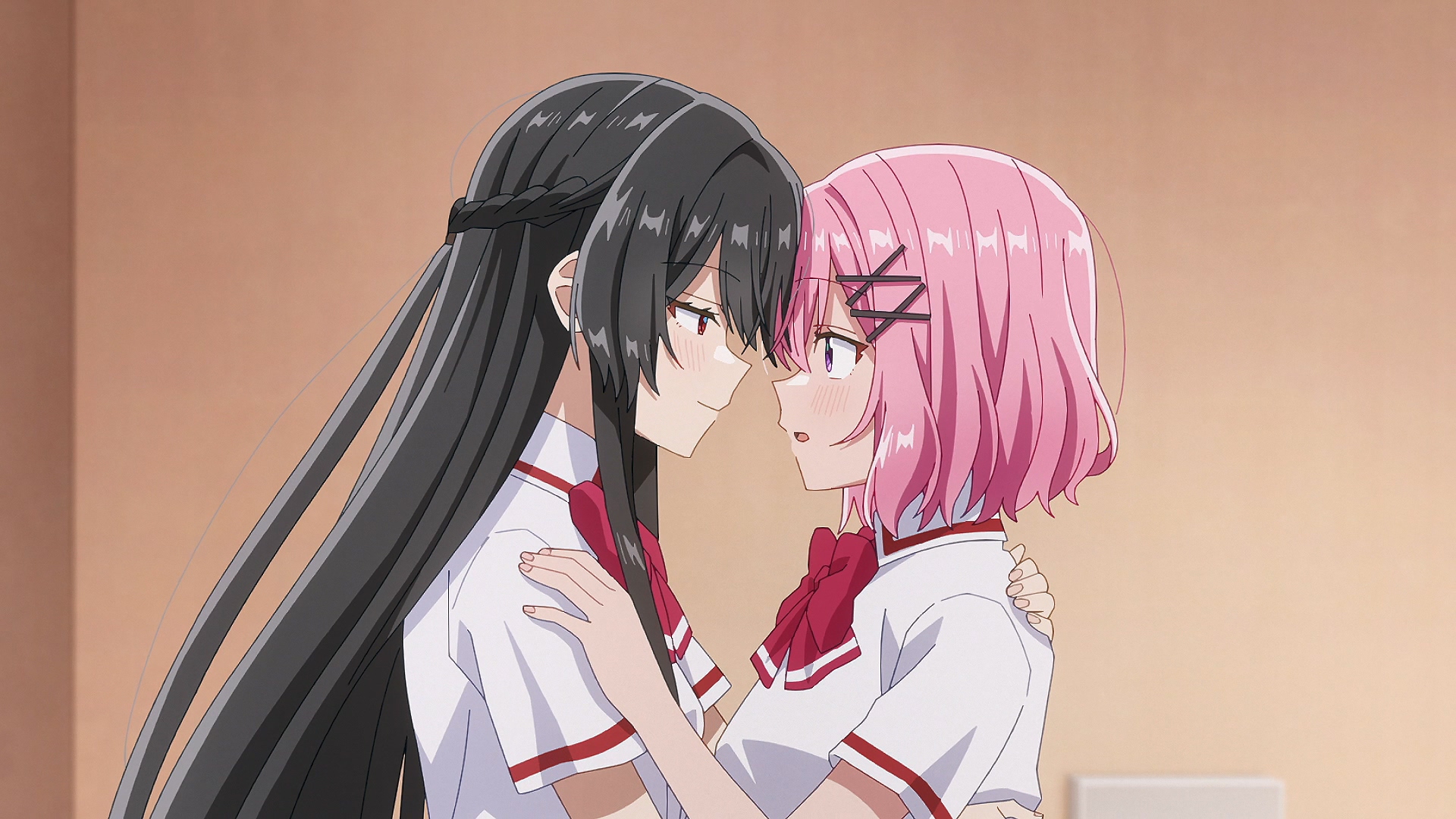🌸 “Twisted Hearts and Sacred Secrets: The Unholy Charm of Maria†Holic”
Introduction: When Love and Laughter Collide in a Church-Like School
In the world of Maria†Holic, love isn’t soft — it’s awkward, ironic, and painfully human.
This is not your typical Girls’ Love story filled with slow blushes and tender glances under cherry blossoms. No — Maria†Holic dances between satire and sincerity, between faith and forbidden attraction.
It’s loud, unpredictable, and sometimes absurd. But beneath its comedic surface lies something more: a raw story about identity, rejection, and the desperate desire to belong — even in the most unconventional ways.
As one of the most misunderstood yuri anime of its time, Maria†Holic remains a fascinating experiment in tone and emotion. It’s both a parody of romantic tropes and a strangely heartfelt story about finding connection in a world that mocks it.
“Sometimes love doesn’t make sense.
But then again, neither do we.” — Kanako Miyamae
The Premise: A Shrine to Chaos and Love
The story follows Kanako Miyamae, a high school girl transferring to the prestigious all-girls Catholic academy Ame no Kisaki. She dreams of meeting her one true love — a beautiful, pure girl who’ll sweep her off her feet and bless her life with romance and warmth.
Kanako is, in every sense, a hopeless romantic… except there’s one problem.
Whenever she gets close to a pretty girl, she breaks out in hives. Literally.
Her dreams of finding gentle love turn into a running gag of exaggerated blushing, nosebleeds, and internal screaming — a hilarious and sometimes painful representation of teenage longing taken to the extreme.
Then enters Mariya Shidou — the perfect girl. Graceful, polite, angelic… and secretly a boy disguised as a girl.
From that moment, Kanako’s world turns upside down.
A Battle Between Love and Deception
At first glance, Maria†Holic looks like a chaotic comedy. But if you look closely, it’s a complex dance between truth and illusion — between how people want to be seen and who they truly are.
Kanako, open about her attraction to girls but awkward and unlucky in love, represents unfiltered emotion.
Mariya, on the other hand, embodies performance — constantly acting, concealing, and manipulating.
The two become unlikely opposites bound by circumstance and secrecy.
Kanako knows she should avoid Mariya — after all, he’s the very opposite of the romantic ideal she dreamed of — yet she can’t. There’s something magnetic about him, something that challenges her to confront her fantasies versus reality.
“Love isn’t always what we expect. Sometimes it’s the person who ruins our expectations that teaches us the most.”
This push and pull between desire and deception creates the strange, addictive rhythm of Maria†Holic.
Themes: The Many Faces of Love and Identity
Though its tone is comedic and exaggerated, Maria†Holic explores surprisingly mature themes beneath its absurd humor.
💫 1. Love as Confusion, Not Clarity
Most love stories in anime are about finding clarity — realizing who you love and why.
But here, love is messy. It’s full of contradictions. Kanako’s attraction isn’t always romantic; sometimes it’s infatuation, sometimes admiration, sometimes desperation.
That’s what makes Maria†Holic so authentic — because real love is rarely simple.
Kanako’s journey isn’t about “winning” love but about understanding herself.
🪞 2. Gender, Masks, and Self-Presentation
Mariya’s gender disguise is more than a gag — it’s a lens through which the anime examines how we perform identity.
He’s both the perfect girl and a manipulative boy — both protector and tormentor.
By existing between roles, Mariya forces everyone around him (and especially Kanako) to question what’s real.
Is Mariya a villain? A savior? Or simply a mirror showing everyone their truest, most insecure selves?
The brilliance of Maria†Holic lies in how it refuses to give easy answers.
🌸 3. Faith and Forbidden Feelings
Set in a Catholic academy, the show constantly plays with the imagery of sin, purity, and temptation.
Kanako’s love is “forbidden” — not just socially but spiritually within her environment.
This setting amplifies her inner conflict: she’s surrounded by crosses and prayers while dealing with desires that religion has historically condemned.
It’s darkly humorous, but also deeply symbolic — showing how love often blooms in the most repressive spaces.
“Even the holiest hearts hide secrets.
Maybe that’s what makes them human.”
The Characters: A Symphony of Chaos and Charm
💋 Kanako Miyamae – The Reluctant Romantic
Kanako is equal parts relatable and ridiculous.
She’s self-aware yet constantly embarrassed by her emotions. Her exaggerated reactions, nosebleeds, and overthinking aren’t just for comedy — they’re a visual metaphor for emotional overload.
What makes her endearing is her honesty. She doesn’t hide her desire or try to be someone she’s not.
In a genre often filled with idealized love, Kanako is refreshingly imperfect.
She’s you. She’s every person who’s ever overthought a crush, stumbled through their feelings, and laughed to hide vulnerability.
🎭 Mariya Shidou – The Angel and the Devil
Mariya is one of the most iconic “trickster” characters in yuri anime.
He’s beautiful, brilliant, manipulative — and enjoys breaking every rule that holds others back.
While his disguise begins as deception, it quickly becomes a commentary on freedom from societal labels.
He doesn’t care about expectations, gender, or norms. He thrives in chaos because that’s where truth hides.
His cruelty toward Kanako isn’t just bullying — it’s almost philosophical. He tears apart her illusions, forcing her to see love as it truly is: uncomfortable, messy, and real.
⛪ Matsurika Shinouji – The Deadpan Voice of Reason
No Maria†Holic discussion is complete without Matsurika, Mariya’s maid and constant companion.
Calm, logical, and brutally sarcastic, she acts as the voice of reason in a story that constantly borders on madness.
Her interactions with Kanako are comedic gold — but her role is deeper. She represents perspective — the ability to see truth amid confusion.
“People who claim to understand love are usually the ones who don’t.” — Matsurika
Tone and Style: A Satire Wrapped in Softness
One of the most fascinating things about Maria†Holic is its tone.
It parodies the very tropes of the yuri genre — yet still delivers moments of genuine affection and emotional honesty.
The director, Akiyuki Shinbo (Monogatari Series), fills every scene with exaggerated angles, visual symbolism, and rapid humor. The result is a story that feels theatrical — like a stage play that never lets the audience breathe too comfortably.
Yet, beneath the laughter and exaggeration lies something tender.
Maria†Holic isn’t mocking love. It’s mocking how we pretend to understand it.
Symbolism: Sin, Salvation, and Self-Discovery
Every element in Maria†Holic — the church setting, Mariya’s cross necklace, the constant “confessional” humor — serves a symbolic purpose.
Kanako’s romantic misadventures mirror her spiritual struggle:
-
She confesses her sins (of attraction) constantly.
-
She’s searching for “purity” in others but can’t accept imperfection in herself.
-
Her journey through the school is like an emotional pilgrimage — not toward romance, but toward self-acceptance.
The anime’s greatest irony?
What Kanako sees as her sin — her attraction to girls — is the very thing that makes her most human, most alive, and most authentic.
Quotes That Capture the Spirit of Maria†Holic
“Love isn’t divine. It’s desperately human.” — Kanako
“I lie because the truth is too simple for people to believe.” — Mariya
“Sometimes the most honest prayer is just a sigh.” — Matsurika
“You can’t confess to God what you won’t admit to yourself.” — Narration
These quotes aren’t just dialogue — they’re emotional truths hiding in comedy.
They remind us that Maria†Holic is not just about laughter, but liberation.
Why Maria†Holic Still Matters
In today’s anime landscape, where Yuri series often play it safe, Maria†Holic stands out as a strange, brave, and hilarious exploration of love and self-image.
It’s not gentle or poetic like Kase-san or Whisper Me a Love Song — but it’s honest in its absurdity.
It acknowledges that sometimes love is awkward, that attraction doesn’t follow rules, and that laughter is often the first step toward healing.
The show doesn’t romanticize pain, but it also doesn’t hide it. It lets it breathe, joke, and exist alongside everything else.
And that’s what makes Maria†Holic unforgettable.
🌹 Episode-by-Episode Journey: When Comedy Becomes Confession
Episode 1: “A Maiden’s Prayer” — Love at First Panic
Kanako’s arrival at Ame no Kisaki Academy is nothing short of cinematic chaos.
The grand gates open to reveal her dream — an elegant world filled with pure-hearted girls and the promise of love.
But the moment she meets Mariya Shidou, that dream begins to unravel.
What starts as admiration quickly spirals into confusion, horror, and absurdity when Mariya’s true identity is revealed. The anime wastes no time showing that this is not your typical yuri fantasy.
Kanako’s exaggerated reactions — the nosebleeds, the fainting, the melodramatic monologues — are hilarious, but they also set the emotional tone: love here is both sacred and ridiculous.
“I prayed for love, not confusion. But maybe God has a sense of humor.” — Kanako
This episode establishes the central irony — in a place meant for purity and devotion, the most chaotic, impure, and painfully human form of love blossoms.
Episode 2: “The Holy Sadist and the Unholy Romantic”
The relationship between Kanako and Mariya begins to evolve into something complex — almost a game of spiritual chess.
Mariya teases and torments Kanako, but never out of pure malice. There’s curiosity in his cruelty — as if he’s testing her emotional endurance.
The audience begins to see Mariya’s dual nature:
-
To Kanako, he’s an angel who’s fallen just for her torment.
-
To himself, he’s simply existing freely — without guilt, without fear.
The humor in this episode cuts deeply — because every joke hides truth.
Kanako’s exaggerated purity clashes with her raw, unfiltered desires. The result is painfully relatable — a depiction of what it’s like to want love, but fear your own emotions.
“The holier I try to be, the more human I feel.”
Episode 3: “The Confession Booth”
One of the most iconic episodes — and the one that truly reveals Maria†Holic’s underlying brilliance.
Kanako’s obsession with her new environment grows, leading her to hilariously overanalyze every girl she meets. The confessional scenes are both comedic and spiritual, blurring the lines between sin and self-discovery.
In one particularly moving scene, Kanako admits she doesn’t just want love — she wants acceptance.
Her attraction isn’t about lust; it’s about being seen, truly seen, by another girl who won’t flinch or judge.
Mariya listens, quietly smirking — yet there’s a fleeting sadness in his eyes. For all his mockery, he understands her loneliness.
Episode 4: “Angels Don’t Wear Lip Gloss”
This episode deepens the aesthetic and visual comedy of the series.
The director, Akiyuki Shinbo, uses abstract backgrounds, shifting frames, and theatrical cuts — making the world feel surreal, like an emotional stage play.
Here, Kanako tries desperately to appear “pure” and “innocent,” but her internal monologues betray her every thought.
The irony of purity and perversion being constantly reversed is one of the anime’s running jokes. But emotionally, it reflects how shame shapes desire — especially in queer love stories.
It’s not about lust; it’s about being told your feelings are wrong, and still feeling them anyway.
Episode 5: “Dorm Room of Deception”
Kanako’s new life in the dorm becomes a daily battle of wits with Mariya and Matsurika.
The humor here is sharper, faster — but it hides emotional vulnerability. Kanako’s comedic failures are metaphors for something deeper: how fragile queer love feels in the wrong environment.
Every time Kanako gets close to someone, her anxiety sabotages her.
She wants connection but fears rejection — an endless loop of wanting and running away.
Mariya’s teasing becomes almost philosophical here. His mockery forces her to reflect on what “love” truly means beyond fantasy.
“You want love to be perfect, Kanako. But what if love is supposed to embarrass you first?” — Mariya
Episode 6: “Prayers for Patience”
This episode slows down the pacing and gives Kanako moments of introspection.
She prays to God for strength — for “the will to stop falling for every cute girl.”
The irony? Her prayer itself is a form of confession, filled with sincerity and contradiction.
In a subtle, poetic moment, the show reveals that Kanako’s struggles are not a joke — they’re real emotional conflicts masked by laughter.
Her desire to love purely, yet fear of her own impulses, mirrors the real-world journey of self-acceptance many LGBTQ+ individuals face.
Episode 7: “Saints and Scandals”
Kanako’s curiosity leads her to uncover a rumored “forbidden relationship” between two upperclassmen.
The rumor spreads like wildfire, and the entire school reacts with judgment and fascination.
Here, Maria†Holic critiques societal hypocrisy. Everyone wants to talk about love — as long as it fits a neat, acceptable mold.
Kanako defends the couple in her own awkward, comedic way, realizing that maybe what she calls “weird” about herself isn’t so unusual after all.
This episode is where Kanako stops being just a caricature and becomes a deeply empathetic protagonist.
“Maybe the only sin is pretending love doesn’t exist when it’s right in front of you.”
Episode 8: “The Holiest Lie”
Mariya’s secret becomes heavier to maintain.
While he continues to tease Kanako, small cracks begin to appear — moments where he seems exhausted by the constant performance.
It’s one of the rare episodes that shows the emotional cost of hiding one’s identity — whether for safety, control, or fear.
Mariya’s disguise isn’t just comedy. It’s a metaphor for how people conceal parts of themselves to survive in environments that wouldn’t accept their truth.
Kanako, in her own chaotic way, begins to see this. She doesn’t understand him — but she starts to empathize.
Episode 9: “Between Crosses and Curtains”
The visual metaphors reach their peak here — stained glass, candlelight, and shadows flood the screen as the show starts exploring loneliness.
Kanako confesses that she doesn’t really know what she’s looking for.
Not just love — but purpose.
The religious setting becomes symbolic of internal struggle — a kind of emotional exorcism.
This is what sets Maria†Holic apart from other girls’ love anime: it doesn’t treat attraction as cute escapism, but as a spiritual awakening that’s as terrifying as it is beautiful.
Episode 10: “When the Angel Sleeps”
The rare quiet episode.
Kanako and Mariya share moments of stillness — reading, eating, talking in the dim dorm light.
For once, the jokes fade, replaced by subtle expressions and small gestures.
You realize that under all the teasing and torment, there’s genuine affection — maybe not romantic, but deeply human.
Mariya may mock her, but he also protects her. He’s her chaos and her balance — her mirror.
“You drive me insane.
But maybe that’s what it means to care.” — Kanako
Episode 11: “The Garden of Awkward Truths”
The penultimate episode brings all themes together.
Kanako, still clumsy and overly dramatic, begins to understand that love doesn’t have to be pure to be meaningful.
She starts to see beauty in her own imperfection.
Mariya, in turn, lets down his guard ever so slightly — revealing that even someone as confident as him hides his insecurities beneath layers of sarcasm.
It’s a stunning commentary on performance, both in gender and emotion.
Episode 12: “A Maiden’s Benediction”
The finale blends chaos and catharsis.
Kanako may not have found romantic love, but she’s found something better: a strange peace with herself.
She accepts her desires, her awkwardness, and her failures — realizing that every part of her is worthy of love, even if no one else says it aloud.
The final moments — her looking up at the stained-glass windows, whispering a small “thank you” — feel like an emotional blessing.
And Mariya, smiling knowingly, simply says:
“You don’t need anyone’s permission to love who you are.”
🌺 The Emotional Core: Laughter as Liberation
At its heart, Maria†Holic isn’t about religion, deception, or even romance — it’s about freedom.
Freedom to love strangely.
Freedom to exist awkwardly.
Freedom to be seen and still stay true.
The comedy doesn’t undermine the emotion — it protects it.
By laughing, the show disarms shame. It tells the audience:
“You can laugh, cry, and desire at the same time. That’s okay.”
This fusion of irony and honesty makes it one of the most emotionally intelligent yuri anime ever made — even if it hides behind absurdity.
❤️ Why It Still Resonates in 2025
In an age of polished, formulaic romance stories, Maria†Holic feels alive.
It’s not afraid to be messy, loud, and contradictory — much like love itself.
It may not fit perfectly into the modern “representation” mold, but that’s part of its magic.
It captures the emotional confusion of discovering your identity in a world that doesn’t quite understand it.
Its impact isn’t in big declarations, but in small realizations — that love, even when twisted, remains sacred.
Final Quote to Leave You With
“Love is not about perfection or purity.
It’s about being brave enough to keep feeling — even when it makes no sense.” — Maria†Holic










